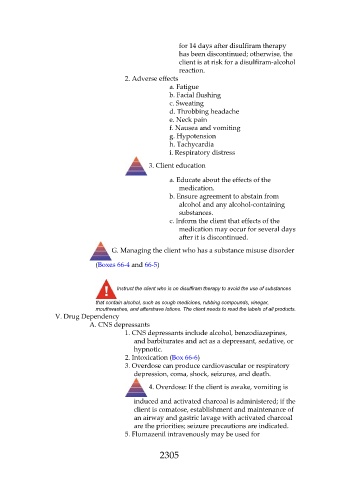Page 2305 - Saunders Comprehensive Review For NCLEX-RN
P. 2305
for 14 days after disulfiram therapy
has been discontinued; otherwise, the
client is at risk for a disulfiram-alcohol
reaction.
2. Adverse effects
a. Fatigue
b. Facial flushing
c. Sweating
d. Throbbing headache
e. Neck pain
f. Nausea and vomiting
g. Hypotension
h. Tachycardia
i. Respiratory distress
3. Client education
a. Educate about the effects of the
medication.
b. Ensure agreement to abstain from
alcohol and any alcohol-containing
substances.
c. Inform the client that effects of the
medication may occur for several days
after it is discontinued.
G. Managing the client who has a substance misuse disorder
(Boxes 66-4 and 66-5)
Instruct the client who is on disulfiram therapy to avoid the use of substances
that contain alcohol, such as cough medicines, rubbing compounds, vinegar,
mouthwashes, and aftershave lotions. The client needs to read the labels of all products.
V. Drug Dependency
A. CNS depressants
1. CNS depressants include alcohol, benzodiazepines,
and barbiturates and act as a depressant, sedative, or
hypnotic.
2. Intoxication (Box 66-6)
3. Overdose can produce cardiovascular or respiratory
depression, coma, shock, seizures, and death.
4. Overdose: If the client is awake, vomiting is
induced and activated charcoal is administered; if the
client is comatose, establishment and maintenance of
an airway and gastric lavage with activated charcoal
are the priorities; seizure precautions are indicated.
5. Flumazenil intravenously may be used for
2305

